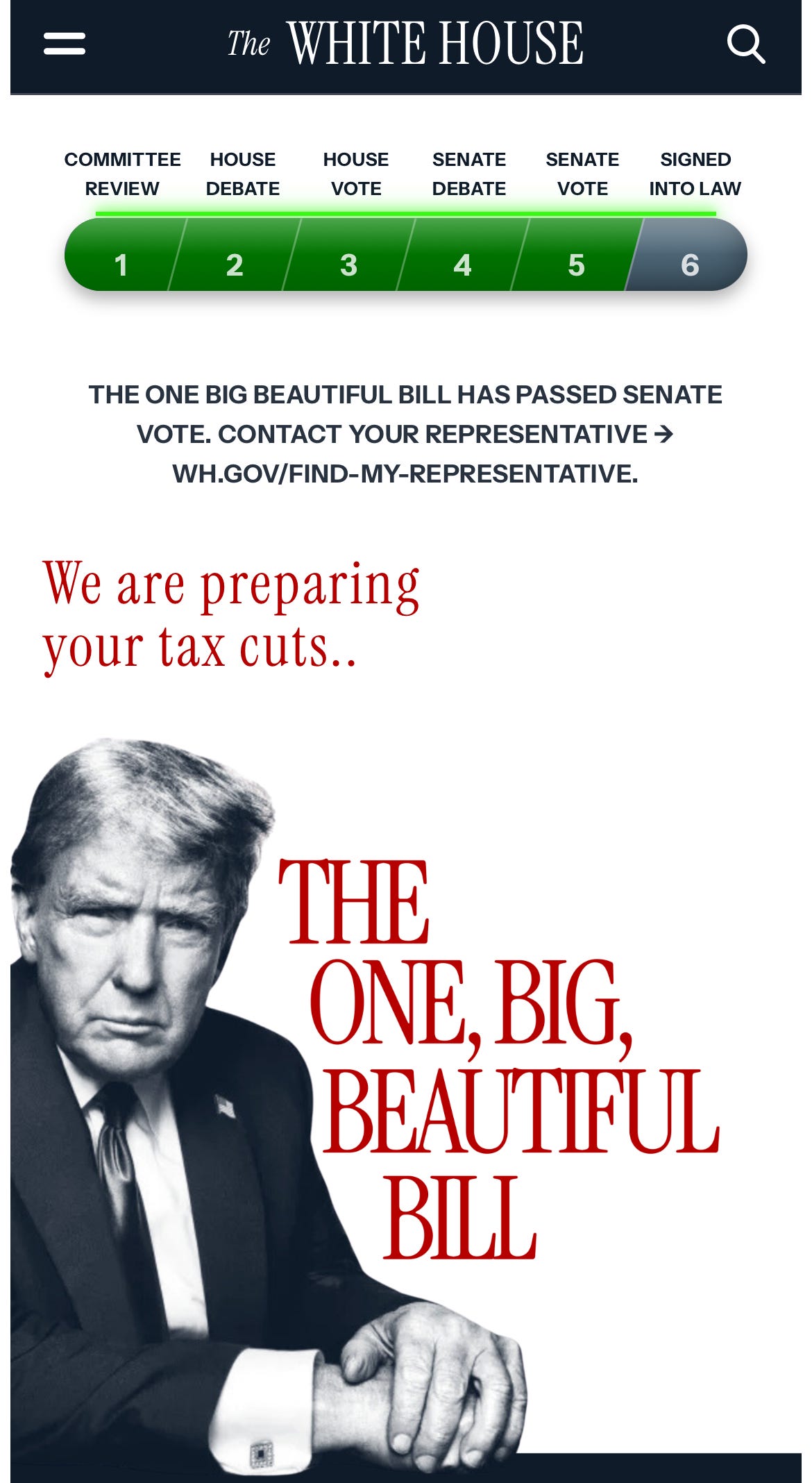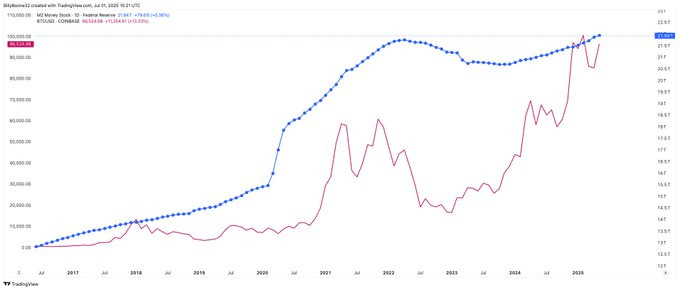Gm Bitcoin investors,
Earlier this year, I wrote a piece on The Debt Problem:
TLDR:
The current U.S. debt according to the debt clock is over $37 trillion.
The “debt ceiling” is the temporary limit Congress gives the Treasury on the debt they can take on (currently $36.1 trillion)
The difference between the actual debt and the debt ceiling is that the actual debt is the amount the U.S. must repay, while the debt ceiling is the cap on the amount the Treasury can borrow.
The problem is overspending. Bills come due, and the goalpost gets moved.
The US has raised this “limit” 78 times since 1960.
The ceiling was hit on Jan. 2, 2025.
The Treasury has been using accounting tricks (“extraordinary measures”) to avoid default.
These measures will be exhausted before September. The limit will need to be raised before then.
Fast forward to today, The One Big Beautiful Bill has passed Senate vote.
This will be a catalyst for $1M Bitcoin and a major incentive for Bitcoin mining.
This is ultimately a spending bill.
It outlines lower taxes and expensive projects, which will increase the "debt ceiling" by ~ $5T.
How will the U.S. pay for this?
Try to keep growth > inflation.
Here is a summary:
• Permanent Extension of TCJA Provisions
Extends the 2017 Tax Cuts and Jobs Act (TCJA) individual tax cuts, including lower tax rates (top rate at 37%), higher standard deductions, and revised tax brackets, set to expire after 2025.
• 100% Bonus Depreciation
Reinstates 100% bonus depreciation for qualified property (e.g., machinery, equipment) acquired and placed in service after January 19, 2025, and before January 1, 2030 (House version) or permanently (Senate version). This allows businesses to immediately deduct the full cost of eligible assets, boosting investment.
• Qualified Business Income (QBI) Deduction
Permanently extends the Section 199A deduction for pass-through entities (e.g., S corporations, LLCs) and sole proprietors. The House version increases it from 20% to 23%, while the Senate keeps it at 20% but adjusts phase-in limits.
• SALT Deduction Cap Increase
Raises the state and local tax (SALT) deduction cap from $10,000 to $40,000 (House) or a lower amount (Senate, possibly $10,000 as a placeholder), with phase-outs based on income. This is a contentious issue, with some House Republicans opposing a lower cap.
• No Tax on Tips and Overtime
Allows deductions for up to $25,000 of tip income and $12,500 ($25,000 for joint filers) of overtime pay for 2025–2028, phasing out for higher earners. Requires a valid Social Security number.
• Car Loan Interest Deduction
Permits a deduction of up to $10,000 for interest on loans for U.S.-assembled vehicles (2025–2028), phasing out for incomes above $100,000 (single) or $200,000 (joint).
• R&D Expensing
Restores immediate expensing of domestic research and development costs for 2025–2029, with options to amortize. Foreign R&D remains subject to amortization.
• Section 179 Expensing
Increases the expensing limit to $2.5 million (from $1.25 million) and the phase-out threshold to $4 million (from $3.13 million) for 2025, adjusted for inflation.
• Child Tax Credit
House version increases it to $2,500 (from $2,000) through 2028, requiring both parents to have Social Security numbers. Senate proposes a permanent $2,200 credit, requiring only one parent to have an SSN.
• Energy Tax Credit Repeals
Phases out or repeals Inflation Reduction Act credits (e.g., electric vehicle, home energy efficiency), with the Senate version allowing slower phase-outs for some projects.
• Debt Ceiling Increase
House proposes a $4 trillion increase; Senate proposes $5 trillion to avoid default by late summer 2025.
• Border Security
Funds a border wall, 10,000 ICE officers, detention beds, and Customs and Border Patrol, with a tax on remittances by illegal immigrants.
• Medicaid Reforms
Introduces work requirements, co-pays for those above the poverty level, and stricter eligibility verification, potentially reducing coverage for millions.
Expands employer-provided childcare and family leave credits, modifies estate tax exemptions (to $15 million), and introduces a new markets tax credit (Senate).
The Senate bill is estimated to increase GDP by 1.1% long-term but reduce federal revenue by $4.7 trillion (conventional) or $3.8 trillion (dynamic) over 2025–2034.
Debt Increase:
Adds $3–5 trillion to the national debt, including interest, over a decade, depending on whether temporary provisions are extended.
This is ultimately bullish for Bitcoin.
We know when $ supply goes up (M2), Bitcoin follows.
Unless there is a fresh wave of demand for USTs, eventually they will end up on the Fed's balance sheet (the entity with the most influence over M2 supply).
Get ready for the next leg up.
What about 100% Bonus Depreciation?
Buying $1M worth of Bitcoin miners?
Deduct $1M off your taxable income — all in year one.
This could put upward pressure on hashrate as the incentive to purchase a BTC-generating ASIC will be much higher.
Now is the time to start moving dry power off the sidelines before the Big Print.
It's hard to know the exact best time to secure a mining position.
But if 100% Bonus Depreciation is an option, it's hard to find a better time to mine Bitcoin.
We are also currently in the process of creating a Miner Financing Program.
This would involve a ~ 50% down payment, with the remainder spread across 20-30 months.
This would allow leveraged exposure to mining if you expect inflation to run hot.
Feel free to shoot us a message if you're interested.
Have a good 4th of July✌️🇺🇸








